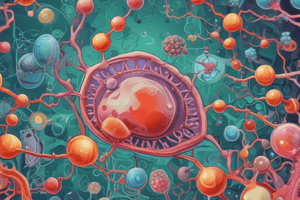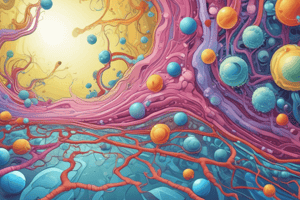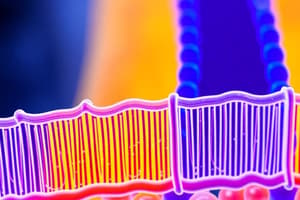Podcast
Questions and Answers
What is the main function of membranes?
What is the main function of membranes?
- To act as a barrier only
- To maintain concentration gradients only
- To enclose reaction compartments only
- To determine what leaves and enters only (correct)
Why do membranes form?
Why do membranes form?
- To cause inverse micelle formation
- Due to phase separation of water and hexane (correct)
- To dissolve detergents
- To facilitate micelle formation
What are amphiphilic molecules?
What are amphiphilic molecules?
- Formed due to phase separation of water and hexane
- contains both polar and non-polar parts (correct)
- Highly soluble in water due to interaction with water dipole
- Dissolve detergents
How do detergents work in aqueous solution?
How do detergents work in aqueous solution?
What is the location of the periplasm region?
What is the location of the periplasm region?
What is the structure of membrane lipids?
What is the structure of membrane lipids?
What is the main function of the inner membrane in prokaryotic cells?
What is the main function of the inner membrane in prokaryotic cells?
What is the main role of cholesterol in cell membranes?
What is the main role of cholesterol in cell membranes?
What drives the formation of cell membranes from phospholipids in an aqueous environment?
What drives the formation of cell membranes from phospholipids in an aqueous environment?
What is the name for the rapid movement of lipids within the leaflet of a membrane?
What is the name for the rapid movement of lipids within the leaflet of a membrane?
What is the exception to the movement between leaflets (flip-flop) in cell membranes?
What is the exception to the movement between leaflets (flip-flop) in cell membranes?
What keeps peripheral proteins attached to the surface of a cell membrane?
What keeps peripheral proteins attached to the surface of a cell membrane?
What is the main reason for using detergent to study integral proteins?
What is the main reason for using detergent to study integral proteins?
What comprises the glycocalyx outside the cell membrane?
What comprises the glycocalyx outside the cell membrane?
What type of structures do integral proteins form in cell membranes?
What type of structures do integral proteins form in cell membranes?
Membranes are permeable to small molecules and impermeable to large molecules
Membranes are permeable to small molecules and impermeable to large molecules
Detergents dissolve in non-polar solvents to form micelles
Detergents dissolve in non-polar solvents to form micelles
Eukaryotic cells have multiple outer membranes for protection
Eukaryotic cells have multiple outer membranes for protection
The structure of membrane lipids includes a glycerol backbone with 3 fatty acids
The structure of membrane lipids includes a glycerol backbone with 3 fatty acids
Amphiphilic molecules contain only non-polar parts and cannot form micelles in aqueous environments
Amphiphilic molecules contain only non-polar parts and cannot form micelles in aqueous environments
Membranes are symmetric, with identical head group distributions in both layers of the bilayer.
Membranes are symmetric, with identical head group distributions in both layers of the bilayer.
Cholesterol acts as a buffer in the presence of cholesterol, leading to increased fluidity at high temperatures.
Cholesterol acts as a buffer in the presence of cholesterol, leading to increased fluidity at high temperatures.
Lipids can make up to 75% of the mass of biological membranes.
Lipids can make up to 75% of the mass of biological membranes.
Integral proteins span only one layer of the lipid bilayer.
Integral proteins span only one layer of the lipid bilayer.
Cholesterol can rapidly undergo transverse diffusion (flip-flop) between the leaflets of the membrane.
Cholesterol can rapidly undergo transverse diffusion (flip-flop) between the leaflets of the membrane.
Study Notes
Membrane Functions and Formation
- Membranes serve as selective barriers, regulating the entry and exit of substances, thus maintaining homeostasis.
- Membranes form due to hydrophobic and hydrophilic interactions among molecules in aqueous solutions, driven by the desire to minimize exposure of hydrophobic tails to water.
Amphiphilic Molecules
- Amphiphilic molecules possess both polar (hydrophilic) and non-polar (hydrophobic) regions, allowing them to interact with both water and lipid bilayers.
Detergents and Membrane Interaction
- Detergents work in aqueous solutions by forming micelles that encapsulate non-polar molecules, facilitating cleaning and disrupting membrane structures.
- Detergents are used in studies of integral proteins because they can solubilize proteins from membranes, enabling analysis of their structure and function.
Membrane Structure and Composition
- Membrane lipids consist of a glycerol backbone, two fatty acid tails, and a phosphate group, forming a bilayer structure.
- Cholesterol stabilizes cell membranes, acting as a fluidity buffer, increasing fluidity at higher temperatures while maintaining membrane integrity.
Prokaryotic Cell Membranes
- The inner membrane in prokaryotic cells serves as a site for energy production and the location of transport proteins, crucial for nutrient uptake.
Lipid Movement and Distribution
- Lipids demonstrate lateral movement within the same leaflet of the membrane, known as lateral diffusion, rapidly redistributing across the bilayer.
- Flip-flop movement (transverse diffusion) between leaflets occurs rarely, but cholesterol can flip-flop, affecting membrane dynamics.
Protein Interaction with Membranes
- Peripheral proteins are held to the membrane surface through electrostatic interactions and hydrogen bonds, contributing to structural integrity and signaling.
- Integral proteins span lipid bilayers and play essential roles in transport, signaling, and acting as receptors.
Cellular Structures and Components
- The glycocalyx, rich in carbohydrates, is found outside the cell membrane and plays diverse roles, including protection and cell recognition.
- Eukaryotic cells are characterized by multiple outer membranes, enhancing protection against environmental stresses.
Membrane Permeability
- Membranes are selectively permeable, allowing small molecules to pass while blocking larger ones, crucial for cellular function and integrity.
Studying That Suits You
Use AI to generate personalized quizzes and flashcards to suit your learning preferences.
Related Documents
Description
Test your knowledge on the properties and formation of biological membranes. Explore concepts such as barrier function, maintenance of concentration gradients, and the role of phase separation. Understand why membranes form and the role of amphiphilic detergents.




